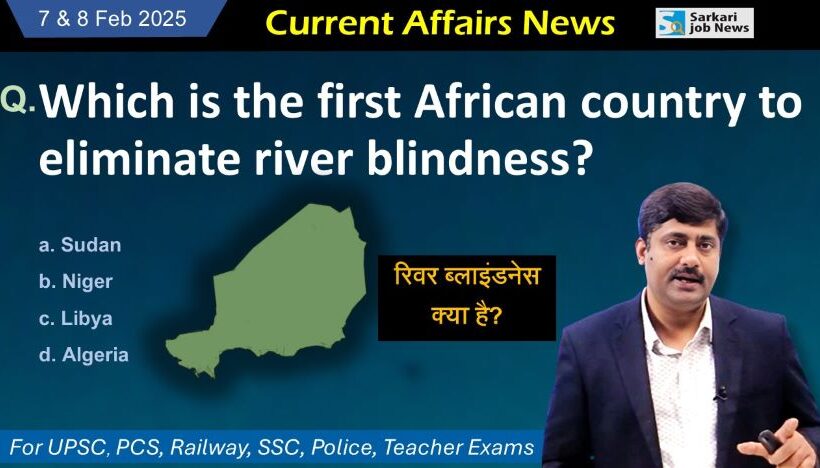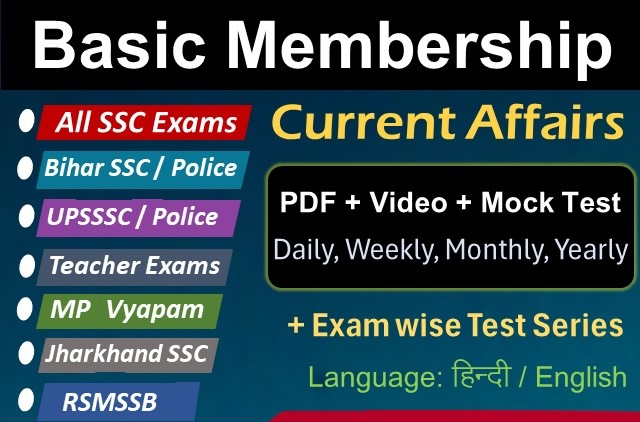This is the current affairs of 7 & 8 February 2025. Here are questions and answers of daily current affairs for better preparation of competitive exams for government jobs.
PDF Download: Click here
1. Which country’s city ‘Goma’ was captured by rebels and 3000 people were killed in this conflict?
a. Bangladesh
b. Sudan
c. DRC
d. Rwanda
Answer: c. DRC (Democratic Republic of Congo)
– The DRC (Democratic Republic of Congo) is one of the countries with the richest mineral resources in the world, but these resources have led to violence, human rights violations, and political instability in the country.
– There has been a civil war going on here for a long time.
– The name of the rebel group is M23. The DRC claims that this group has the support of Rwanda.
– On January 26, 2025, M23 and its ally, the Rwandan army, entered the city of Goma in the DRC.
– This city is adjacent to Rwanda and has a population of 2 million. Near this city is Lake Kivu, which is half in the DRC and half in Rwanda.
– The UN Special Representative, Bintu Kita, has stated to the media that the M23 fighters continued advancing by using local people as human shields.
– Despite the presence of United Nations peacekeepers, DRC’s soldiers had to retreat.
– As a result, M23 took control of the entire city.
– The streets of the city were filled with corpses.
– Now, the rebel group is advancing toward the neighboring South Kivu province.
3000 Deaths
– United Nations Human Rights Chief Volker Turk has stated that since the M23 entered Goma on January 26, 2025 (as of February 6), nearly 3,000 people have died.
– Approximately 2,880 people have been injured.
– The final number of deaths and injuries will likely be much higher.
– Volker Turk has confirmed several allegations of rape, mass rape, and sexual slavery by the rebel group M23.
United Nations Peacekeepers Trapped
– After taking control of Goma city, M23 has closed the airspace over the area.
– The United Nations peacekeepers’ camp is also located in the city. The United Nations is attempting to evacuate them.
How Many Indian Peacekeepers Are Serving in Congo?
– Indian Ministry of External Affairs spokesperson Randhir Jaiswal stated that nearly 1,200 Indian soldiers are serving in the country as part of the MONUSCO (United Nations Mission in the Democratic Republic of Congo) peace mission in eastern Congo. The purpose of MONUSCO is to protect civilians from violence and provide humanitarian assistance.
History of the M23 Rebellion
– The M23 rebellion is an armed rebel group active in the eastern region of the Democratic Republic of Congo (DRC).
– In fact, after the 1994 Rwandan genocide, millions of refugees, including Rwanda-supported rebels, arrived in the eastern region of DRC. (Note: Around 800,000 people were killed in the 1994 Rwandan genocide, most of them from the Tutsi ethnic group, killed by the Hutu militia.)
– Due to the abundance of resources in this region and ethnic tensions, several rebel factions emerged, mainly from the Tutsi community.
– In 2009, a peace agreement was reached between the Congolese government and a rebel group called the “National Congress for the Defense of the People” (CNDP).
– CNDP was mainly associated with the Tutsi community and supported the interests of Rwanda.
– Under this agreement, CNDP fighters were to be integrated into the national army and given good positions within the army.
– The goal of the agreement was to bring stability to eastern DRC.
– After the agreement, several CNDP fighters were incorporated into the Congolese army, but they did not receive high-ranking positions. The government was accused of trying to weaken these soldiers and break their unity.
– This dissatisfaction led to some former CNDP members rebelling against the DRC army in 2012, forming a new rebel group called the March 23 Movement (M23).
– The name of the group comes from the fact that they considered the March 23, 2009, agreement a “betrayal.”
– The M23 rebellion mainly arose from a lack of trust and dissatisfaction with the 2009 agreement between the Congolese government and CNDP. Due to ethnic, political, and regional issues in Congo, this conflict continues to this day.
The Root of the Rebellion is the Reserve of Rare Earth Metals
– The DRC is home to some of the world’s most valuable minerals, found in large quantities. The eastern region, where the conflict is taking place, has a higher concentration of these minerals.
– These minerals are extremely important for the global economy.
– The mineral reserves of DRC have become a source of income for several armed rebel groups (like M23).
– These rebel groups make money through illegal mining and mineral smuggling, which they use to purchase weapons, fueling the ongoing conflict and violence.
– The United Nations and several international organizations have labeled these minerals as “Conflict Minerals.”
Key Minerals
– Cobalt: DRC is the world’s largest producer of cobalt (approximately 70% of global production). It is used in electric vehicle (EV) batteries, smartphone and laptop batteries, aircraft, and military equipment.
– Copper: DRC is one of the largest copper-producing countries in the world. It is used in electrical wiring and cables, construction and infrastructure, and electronic devices.
– Coltan (Columbite-Tantalite): DRC holds nearly 60% of the world’s coltan reserves. It is used in mobile phones, laptops, and other electronic devices, aerospace, and medical equipment.
– Tungsten: DRC has large quantities of tungsten. It is used in industrial machinery, light bulbs, electronic chips, and weapon manufacturing.
– Tin: It is used in food packaging (canning), electronic circuit boards, and soldering (the process of joining metals).
– Diamonds: DRC is the largest producer of industrial diamonds in the world. They are used in jewelry, industrial cutting, and drilling tools.
– Gold: DRC has large gold reserves, particularly in the eastern region. It is used in jewelry and investments, as well as electronics and medical devices.
Rising Tensions Between Congo and Rwanda
– The M23 attack in January 2025, with the support of Rwanda, has increased the possibility of a regional war.
– This is because several countries, including South Africa, Burundi, and Malawi, are providing military support to the DRC.
DRC (Democratic Republic of Congo)
– Capital: Kinshasa
– Prime Minister: Judith Suminwa Tuluka
– President: Félix Tshisekedi
– Currency: Congolese Franc
– Population: 6.5 million (2023)
– Language: French
– Neighboring Countries: Angola, Burundi, Central African Republic, Republic of Congo, Sudan, Rwanda, Tanzania, Uganda, Zambia.
Unstable Africa
– On May 19, 2024, there was an attempted coup in the Democratic Republic of Congo (DRC).
List: Coup Attempts in African Countries
– Gabon: August 2023
– Niger: July 2023
– Burkina Faso: January 2022
– Guinea: September 2021
– Chad: April 2021
– Mali: August 2020
– Sudan: April 2019
————–
2. In which African country, due to civil war, the Indian Embassy advised its citizens to immediately move to safer places in February 2025?
a. Bangladesh
b. Sudan
c. DRC
d. Rwanda
Answer: c. DRC (Democratic Republic of Congo)
– The Indian Embassy in Kinshasa, Congo, issued three advisories on February 2, 2025, urging Indians to leave the city of Bukavu immediately and move to safer locations.
In case of an emergency, where to contact?
– A contact number (+243 890024313) and an email ID (cons.kinshasas@mea.gov.in) have been provided for Indian citizens to reach out in case of an emergency.
– Around 25,000 Indians live in Congo, with about 1,000 residing in areas affected by the civil war.
————–
3. Which state approved the proposal to set up a white tiger breeding centre in February 2025?
a. Madhya Pradesh
b. Uttar Pradesh
c. Bihar
d. Karnataka
Answer: a. Madhya Pradesh
– The Central Zoo Authority (CZA) has approved the proposal to establish a white tiger breeding center in the Rewa district of Madhya Pradesh in February 2025.
– It is believed that the last white tiger in the wild was found here.
– The state’s Deputy Chief Minister, Rajendra Shukla, stated that this facility will enhance the protection of white tigers and increase their numbers.
– The central government had given in-principle approval for the project in 2011. Now, the breeding center will be set up in Govindgarh.
– The state’s only white tiger safari is located in Mukundpur.
– The white tiger breeding center is part of the revised master plan for the Maharaja Martand Singh Judev White Tiger Safari and Zoo in Mukundpur.
– The safari is named after the last Maharaja of Rewa.
– In 1951, he discovered a white tiger in the Govindgarh forest, which he named Mohan. He was so fascinated by it that he initiated a white tiger breeding and conservation program.
Madhya Pradesh
– Capital: Bhopal
– Chief Minister: Mohan Yadav
– Population: 87.7 million (2011)
– Neighboring States: Uttar Pradesh, Chhattisgarh, – Maharashtra, Gujarat, Rajasthan.
————–
4. Which has become the first African country to eliminate onchocerciasis (river blindness)?
a. Sudan
b. Niger
c. Libya
d. Algeria
Answer: b. Niger (West African country)
– The Minister of Public Health, Population, and Social Affairs of Niger, Garba Hkimi, provided this information in January 2025.
– Niger became the fifth country in the world and the first in Africa to eliminate Onchocerciasis.
– Four countries in the Americas have also eliminated Onchocerciasis:
1. Colombia (2013)
2. Ecuador (2014)
3. Guatemala (2016)
4. Mexico (2015)
Note: According to the WHO, more than 99% of infected people live in Africa and Yemen; the remaining 1% live along the border between Brazil and Venezuela (Bolivarian Republic of).
About Onchocerciasis (River Blindness)
– This disease is spread by the bite of a black fly that carries the parasitic worm of the Simulium genus.
– These flies live near rivers, which is why the disease is commonly called “River Blindness.”
– It is a disease affecting the eyes and skin.
– Small parasitic worms called microfilariae circulate in the body.
– When they die, they cause swelling and irritation.
– Infected people experience severe itching and various skin changes.
– There can be eye damage leading to vision loss and blindness.
– Lumps may form under the skin.
– The risk of epilepsy increases in children.
Niger
– Niger, officially the Republic of Niger, is a landlocked country in West Africa.
– It shares borders with Libya, Chad, Nigeria, Benin, Burkina Faso, Mali, and Algeria.
– Capital: Niamey
– Currency: West African CFA Franc
Note:
– On July 27, 2023, the military carried out a coup in Niger.
– Armed soldiers entered the presidential palace and seized control of it.
– President Mohamed Bazoum was removed from power and arrested.
—————-
5. Name the winning team of ICC Under-19 Women’s T20 World Cup 2025?
a. Sri Lanka
b. South Africa
c. India
d. England
Answer: c. India
– India won the final match of the ICC Under-19 Women’s T20 World Cup for the second consecutive time.
—————
6. Which team did India defeat in the final of the ICC Under-19 Women’s T20 World Cup 2025?
a. Sri Lanka
b. South Africa
c. England
d. Afghanistan
Answer: b. South Africa
– India defeated South Africa by 9 wickets in the final.
– The final match was played on February 2, 2025, at the Bayumas Oval Ground in Kuala Lumpur, Malaysia.
Under-19 Women’s T20 World Cup 2025
– When was the final match?: February 2, 2025
– Where was it held?: Bayumas Oval Ground, Kuala Lumpur, Malaysia
– Which teams played the final?: India and South Africa
– India’s Captain: Nicky Prasad
– South Africa’s Captain: Kayla Renecke
– This was the second edition in 2025.
– The first edition was in 2023.
Final Match Score
– South Africa: Scored 82 runs in 20 overs.
– India: Scored 84 runs in 11.2 overs, losing 1 wicket.
– India won by 9 wickets.
– Note: India won the first Women’s U-19 T20 World Cup 2023 by defeating the England team.
International Cricket Council (ICC)
– Founded: 1909
– Initially, it was named the Imperial Cricket Conference.
– In 1989, its name was changed to the International Cricket Council (ICC).
– It has 108 members.
– Headquarters: Dubai, United Arab Emirates.
————–
7. When is the International Day of Zero Tolerance for Female Genital Mutilation observed?
a. 3 February
b. 4 February
c. 5 February
d. 6 February
Answer: d. 6 February
– The International Day of Zero Tolerance for Female Genital Mutilation is observed globally on February 6.
– It is celebrated by the United Nations to eradicate female genital mutilation.
– It was first observed in 2003.
– The aim of the day is to foster respect and affection for women among people.
————-
8. In which country a law was passed to give legal personhood to the mountain Mount Taranaki?
a. Australia
b. New Zealand
c. Poland
d. Scotland
Answer: b. New Zealand
– On January 30, 2025, New Zealand’s Parliament passed a law granting legal rights to a mountain, treating it like a person.
– This mountain, named Mount Taranaki, will now be known as ‘Taranaki Maunga’.
– The passing of this law means that Mount Taranaki will effectively own itself, and local tribes, Iwi, and government representatives will jointly manage it.
– The aim of this law is to compensate the Māori people of the Taranaki region for the injustices they suffered during colonization, including land confiscations.
– In fact, the Māori tribes have revered Mount Taranaki for centuries, not as a mountain, but as an ancestor, symbolizing their cultural identity.
– Government minister Paul Goldsmith stated that it has been agreed that there will be no changes to access to the mountain, and “all New Zealanders will be able to continue visiting this magnificent place for generations to come.”
New Zealand’s Third Natural Feature with Legal Personality
– This mountain is not the first natural feature in New Zealand to be granted legal personality.
– In 2014, the Ureweras forest became the first forest to gain such status, followed by the Whanganui River in 2017.
New Zealand
– Capital: Wellington
– Prime Minister: Christopher Luxon
– Population: 5.22 million (2023)
– Currency: New Zealand Dollar
– Neighboring Country: Australia
————–
9. The Supreme Court has given permission to all the High Courts of the country to appoint retired judges on ad hoc (temporary) basis. Under which article of the Constitution has this been given?
a. Article 224A
b. Article 224
c. Article 225
d. Article 224(1)
Answer: a. Article 224A
– Under Article 224A, there is a provision for the temporary appointment of retired judges in High Courts.
– In view of the over 1.8 million pending criminal cases in the country, the Supreme Court has granted this approval.
– However, the Court also clarified that this should not become a regular process, and ad hoc judges cannot claim the right to regular appointments.
– In April 2021, the Supreme Court had directed the temporary appointment of retired High Court judges for two to three years.
– It stated that ad hoc judges could only be appointed in those High Courts where less than 20 percent of positions are vacant.
– Now, a special bench of Chief Justice Sanjiv Khanna, Justice BR Gavai, and Justice Suryakant has said that each High Court may appoint two to five temporary judges.
– This should not exceed 10 percent of the total approved number of judges.
– Temporary judges will sit on a bench headed by a sitting High Court judge and will decide on pending criminal appeals.
Article 224A
– Article 224A relates to the appointment of retired judges in the proceedings of High Courts.
– It means that the Chief Justice of a state’s High Court, with the approval of the President, may request a person who has previously been a judge in that court or any other High Court to act as a judge.
– Such a person will receive allowances determined by the President and will be given all the rights, powers, and privileges of a judge, but will not be considered a full-time judge of the High Court.
————–
10. Senior news reader of Akashvani Venkataraman passed away on 4 February 2025, how old was he?
a. 95
b. 99
c. 100
d. 102
Answer: d. 102
– Venkataraman was the first person to announce the important news of India’s independence in Tamil from Delhi on the morning of 15th August 1947.
– Venkataraman was the first person to announce the news of India’s independence in Tamil from Delhi on the morning of 15th August 1947.
– This news was broadcast in Tamil at 5:45 AM on Radio Ceylon (Asia’s first radio station).
– He began his career as a scriptwriter.
– When he joined radio, he was a screenwriter.
– Later, he joined the Tamil news department in New Delhi.
– Venkataraman worked for 64 years as a regular and occasional artist at All India Radio.




